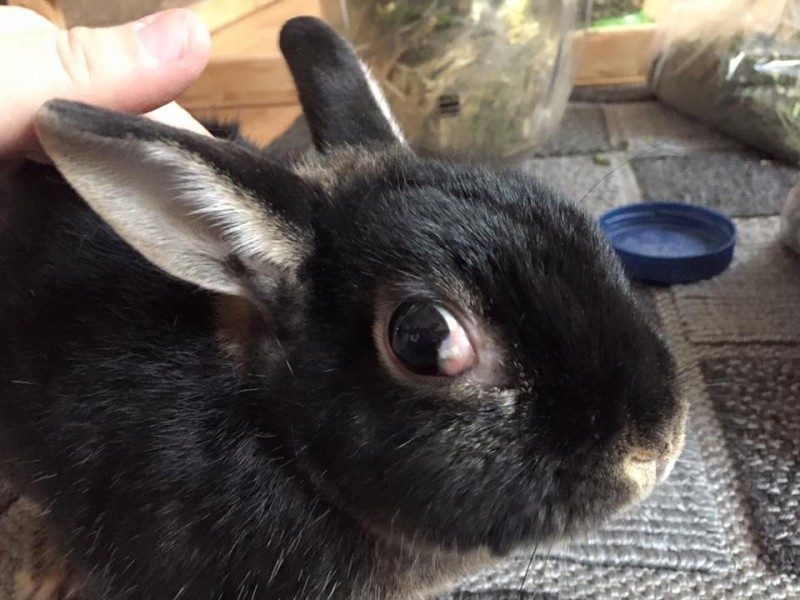Thymoma and Lymphoma
A thymoma is the medical term for a tumor or growth of the thymus. The thymus is part of the lymphatic system and is located next to the heart, making it an integral part of the immune system. Most thymomas are benign growths, with only about a quarter being malignant (thymic carcinoma or malignant thymoma). Thymomas are much more common in rabbits than in other mammals, and they typically affect older rabbits (usually five years or older). Castrated male and female rabbits are more likely to be affected than uncastrated ones.
Lymphoma refers to a growth in the lymph nodes, which are part of the immune system. Like thymomas, lymphomas are usually benign and cause medical symptoms mainly due to their size. Lymph nodes can also become significantly enlarged due to infections.

Contents
Symptoms
The first symptom is usually the protrusion of the nictitating membrane (third eyelid), which often occurs when the rabbit lowers its head, such as when eating or under stress. Typically, the nictitating membrane only temporarily protrudes and then retracts. The eyes may also bulge out, appearing somewhat protruded.
Rabbits often lose weight gradually, move less, or seem less active than before.
In the advanced stages, respiratory distress may occur as the thymoma presses on the heart, potentially hindering its normal function. The symptoms will resemble those of a heart condition. The rabbit may exhibit labored breathing from the sides of the chest and nostrils, and the heart sounds may be muffled upon auscultation. In some cases, fluid accumulation may occur in the lungs and abdominal cavity as a result.
Skin disorders are rare but may occur, showing as coat changes, with dandruff being relatively common and skin inflammation occurring less frequently. Symmetrical hair loss on the head and abdomen is often observed.
In lymphoma, it may spread to other body areas (typically involving the lymph nodes), and in cases of severe progression, it may cause little or no respiratory distress.
Diagnosis
The growth can usually be seen on an X-ray. A heart ultrasound is used to rule out heart diseases, while a biopsy (tissue sample) provides an accurate diagnosis and helps differentiate from lung tumors and abscesses, though it is not always performed. In the case of lymphoma, an increase in lymphocytes may be observed in the blood test, and this can be further examined through a blood smear. A pseudoleft shift in the blood may be an indicator of lung abscesses.
Treatment
Medication Therapy:
- Typically, an ACE inhibitor (e.g., Prilium or Benefortin) is prescribed to lower blood pressure. If fluid accumulation occurs, a diuretic (e.g., Dimazon) may be useful.
- To inhibit tumor growth and, in the best case, reduce it, a low dose of corticosteroids (e.g., Prednisolone, 1mg/kg orally) has been found effective, especially if the tumor is already large or if respiratory distress occurs.
Side effects: Rabbits are sensitive to steroids! Corticosteroids are only suitable for a few conditions. Possible consequences include immunosuppression, which can lead to issues like the outbreak of coccidiosis, E. cuniculi (EC), mites, or rabbit snuffles. Severe liver damage or liver failure, gastrointestinal ulcers, and delayed wound healing are also possible. The EC status must be tested beforehand, and EC-positive rabbits should be treated with Fenbendazole (Panacur). Corticosteroids are considered the treatment of choice and often produce better results than radiation or surgical treatments.
- For respiratory issues, Theophylline can also be used, which works similarly to corticosteroids but has fewer side effects. However, it does not reduce tumor size.
- Additionally, other tumor therapies, such as Heel therapy or mistletoe therapy, are commonly used. These are tailored to the animal and the tumor. However, their effectiveness has not been scientifically proven.
- Note: Immune-boosting or immune-enhancing medications should never be administered.
Surgical Treatment for Thymoma:
Surgical removal of the thymoma is generally not recommended, as over 70% of rabbits die shortly after or during the surgery (due to high anesthesia risks!). For the rabbits that survive, the thymoma often grows back within a few months.
Radiation for Benign Thymoma:
- Radiation can be beneficial for benign thymomas, as it can shrink the tumor for a period of time or permanently.
- Studies have shown that about 15% of rabbits died during the first two weeks of radiation treatment. The remaining rabbits had an average survival time of over two years (with an average age of just under 7 years at the start of radiation treatment!). In another study, irradiated rabbits survived between just under one year and almost three years.
- Initial radiation can achieve a 50% reduction in tumor size, allowing rabbits with larger thymomas to breathe more easily. Further radiation treatments did not result in a significant reduction in one study.
- Possible side effects: Pneumonia, heart failure, localized hair loss, pain.
- Conclusion: Radiation therapy is not widely available, and there are still relatively few cases reported. It is most beneficial for early-diagnosed, benign thymomas or for large thymomas to improve breathing, but it comes with higher costs. The success of radiation therapy also depends on the experience of the clinic with rabbits.
Euthanasia:
If the condition worsens and the rabbit suffers from (persistent/non-treatable) severe respiratory distress, it should be euthanized.
Sources include:
Andres et al. (2012): The use of megavoltage radiation therapy in the treatment of thymomas in rabbits: 19 cases. Vet Comp Oncol 2012; 10: 82-94
Ewringmann, Anja (2016): Leitsymptome beim Kaninchen: Diagnostischer Leitfaden und Therapie. Georg Thieme Verlag
Bertram C., et al. (2021): Neoplasia and tumor-like lesions in pet rab- bits (Oryctolagus cuniculus): a retrospective analysis of cases between 1995 and 2019. Vet Pathol 2021;58:901–911.
Gabrisch, Karl (2015): Krankheiten der Heimtiere, 8. vollständig überarbeitete Auflage, Schlütersche
Künzel, Frank (2013): Thymom – ein unterdiagnostiziertes klinisches Problem beim Kaninchen? Veterinär-Spiegel 23.01: 22-25.
McCready, J. E., Poirier, V. J., Fleck, A., Darco, J., & Beaufrère, H. H. (2022): Adaptive radiation therapy using weekly hypofractionation for thymoma treatment: A retrospective study of 10 rabbits. Veterinary and Comparative Oncology, 20(3), 559-567.
Morrisey, J. K., & McEntee, M. (2005): [Englisch] Therapeutic Options for Thymoma in the Rabbits
Palmer, A., Wu, C. C., Miwa, Y., Turek, M., & Sladky, K. K. (2021): Outcomes and survival times of client-owned rabbits diagnosed with thymoma and treated with either prednisolone or radiotherapy, or left untreated. Journal of Exotic Pet Medicine, 38, 35-43.
Praag, E.: [Englisch] Sebaceous adenitis associated to thymoma in rabbits




















